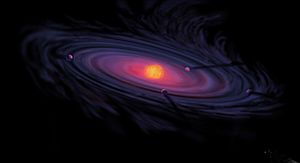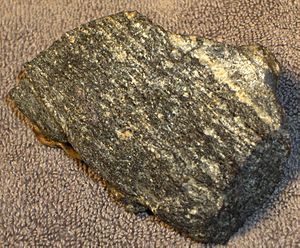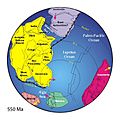History of the Earth facts for kids

The history of the Earth tells the amazing story of our planet, from when it first formed until today. Scientists from many different fields have helped us understand the main events of Earth's past. Our planet is about 4.56 billion years old. This means Earth is about one-third as old as the universe itself!
Contents
How Earth Began: The Hadean Eon
The Birth of Our Solar System
Our Earth formed as part of the Solar System. It started as a huge spinning cloud of dust and gas. This cloud was made of hydrogen and helium from the Big Bang. It also had heavier elements from exploding stars called supernovas.
About 4.68 billion years ago, this cloud began to shrink and spin faster. This might have happened because a nearby star exploded. As the cloud spun, it flattened into a disc. Most of the material gathered in the middle, becoming very hot. This hot center would later become our Sun.
The rest of the disc broke into rings. Gravity pulled dust particles together in these rings. Small pieces bumped into each other and grew larger. One of these growing clumps, about 150 million kilometers from the center, became Earth. When the Sun became hot enough, nuclear fusion started. The solar wind then blew away most of the leftover dust and gas.
How the Moon Formed
The Earth's natural satellite, the Moon, is quite special. Scientists studied rocks brought back from the Moon by the Apollo program. These rocks show the Moon is about 4.527 billion years old. This is a bit younger than other bodies in our solar system.
The Moon also has a low density. This means it does not have a large metallic core like other rocky planets. Its makeup is very similar to Earth's outer layers (mantle and crust), but without Earth's core. This led to the "giant impact hypothesis." This idea suggests the Moon formed when a huge object crashed into the early Earth.
This object, sometimes called Theia, was probably a bit smaller than Mars. It hit Earth about 4.533 billion years ago. Models show that if Theia hit Earth at a low angle and speed, a lot of material would have been thrown into space. This material came from the outer layers of both Earth and Theia.
Most of this material stayed in orbit around Earth. Over time, it came together to form the Moon. The metallic core of Theia would have sunk into Earth's core. This explains why the Moon has so little metal. The material in orbit could have formed a single body in just a few weeks. Gravity then shaped it into a sphere, becoming our Moon.
This huge crash had big effects on the young Earth. It released a massive amount of energy. Both Earth and the Moon became completely melted. Earth's first atmosphere was likely blown away. The impact also tilted Earth's axis by 23.5 degrees. This tilt is what gives us our seasons! It might have even made Earth spin faster.
Early Life and Continents: The Archean Eon
Earth's Hot and Active Past
At the start of the Archaean eon, Earth was much hotter than it is today. Its heat flow was nearly three times higher! This meant that tectonic plate movement and volcanic activity were very strong. Earth's crust was thinner and likely broken into many more tectonic plates. There were many hot spots and rift valleys.
During this time, there were no large continents. Instead, many small protocontinents existed. These small landmasses could not join together easily because of all the geological activity. They likely formed in hot spots from melted rocks.
The Archean atmosphere had no free oxygen. Temperatures were similar to today, even though the sun was dimmer. Scientists think this was because there were more greenhouse gases in the air.
Ancient Rocks and Landmasses
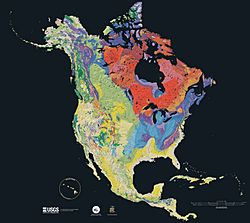
The oldest rock formations we see on Earth's surface are from the Archean eon. These rocks are found in places like Greenland, Canada, western Australia, and southern Africa. Even though the first continents formed then, Archean rocks make up only about 7% of today's landmasses. This suggests that only a small part of our current continental crust formed during the Archean.
Unlike later rocks, Archean rocks are often heavily changed by heat and pressure. Many are deep-water sediments like greywackes and mudstones. Greenstone belts are common Archean formations. These are made of alternating high and low-grade metamorphic rocks. They show how small protocontinents came together.
The First Life Forms
Fossils of cyanobacterial mats, called stromatolites, are found throughout the Archean. They became very common later in this eon. Some other possible bacterial fossils have also been found. Scientists have also found microfossils of archaea, which are tiny living things that can survive in extreme conditions.
There is no known fossil evidence of eukaryotes (cells with a nucleus) or viruses from the Archean eon. Life was still very simple.
Oxygen and Supercontinents: The Proterozoic Eon
Earth's Changing Landscape
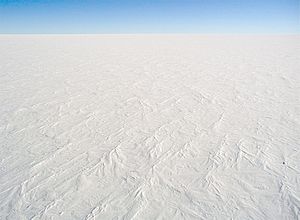
The Proterozoic eon has a much better geologic record than the Archean. Many rocks from this time were laid down in wide, shallow seas. Also, many of these rocks are less changed by heat and pressure. Studying these rocks shows that continents grew quickly during this eon. There were also cycles where continents joined to form supercontinents and then broke apart.
The first known glaciations, or ice ages, happened during the Proterozoic. One ice age began shortly after the eon started. There were at least four more during the later part of the Proterozoic. The biggest one was the "Snowball Earth" event, when much of the planet was covered in ice.
The Rise of Oxygen
One of the most important events of the Proterozoic was the buildup of oxygen in Earth's atmosphere. Even though photosynthesis (which makes oxygen) started in the Archean, oxygen could not build up much at first. This was because it reacted with other chemicals like sulfur and iron.
Until about 2.3 billion years ago, oxygen levels were only 1% to 2% of what they are today. Banded iron formations, which give us most of the world's iron ore, show this. These formations stopped forming after 1.9 billion years ago. This happened either because oxygen increased or because ocean waters mixed more thoroughly.
Red beds, which are rocks colored red by haematite (an iron oxide), show an increase in atmospheric oxygen after 2 billion years ago. These are not found in older rocks. The oxygen buildup likely happened for two reasons: all the "chemical sinks" (like iron) were filled, and more carbon was buried. This stored organic compounds that would have otherwise used up oxygen.
Life Gets More Complex
The first advanced single-celled life and multi-cellular life appeared around the same time as oxygen increased. This might be because eukaryotes (cells with a nucleus) use oxidized nitrates, which became more available. It was also during the Proterozoic that symbiotic relationships developed. For example, mitochondria (which give energy to animals and protists) and chloroplasts (which help plants make food) started living inside other cells.
Eukaryotes like acritarchs grew in number, as did cyanobacteria. In fact, stromatolites were most common and diverse during the Proterozoic, peaking about 1.2 billion years ago.
The boundary between the Proterozoic and the Paleozoic eon used to be marked by the first appearance of trilobites. Now, it is set at 542 million years ago, even though some older animal fossils have been found.
The Age of Animals: The Phanerozoic Eon
The Paleozoic Era: Life Explodes!
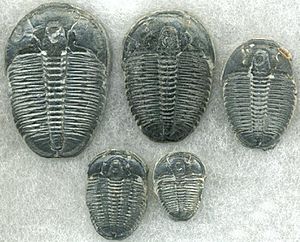
The Paleozoic Era covers the time from when many hard-shelled fossils first appeared. It ends when large, complex reptiles and modern plants started to dominate the land. This era lasted about 250 million years. It ended with a huge extinction event called the Permian–Triassic extinction event.
Geologically, the Paleozoic began after a supercontinent called Rodinia broke apart. It also followed a global ice age (the Snowball Earth). At the start of the era, Earth's land was broken into many smaller continents. By the end, these continents had joined to form a new supercontinent called Pangaea.
At the start of the era, life was simple. It included bacteria, algae, sponges, and strange creatures called the Ediacaran fauna. Then, a huge number of new life forms appeared very quickly. This event is known as the Cambrian Explosion.
Simple life might have moved onto land early in the Paleozoic. But large plants and animals did not truly live on land until the Silurian period. They really thrived in the Devonian period. Early vertebrates (animals with backbones) appeared early on. But invertebrates (animals without backbones) were most common until the middle of the Paleozoic. Fish populations grew rapidly in the Devonian. Later in the Paleozoic, huge forests of early plants grew on land. These forests formed the great coal beds we use today. By the end of the era, the first large, complex reptiles and modern plants (like conifers) had developed.
The Mesozoic Era: Age of Dinosaurs
The Mesozoic Era is known as the time when large, complex reptiles ruled the Earth. It began after the P/Tr extinction event and ended with the K/T extinction event.
Geologically, the Mesozoic started with almost all of Earth's land joined together as Pangaea. During this era, Pangaea split into two main continents: Laurasia in the north and Gondwana in the south. Laurasia then split into North America and Eurasia. Gondwana slowly broke apart into South America, Africa, Madagascar, India, Australia, and Antarctica.
The Mesozoic is famous as the Age of Dinosaurs. It also saw the development of early birds and mammals. Later, flowering plants appeared. By the end of the Mesozoic, all the main types of modern life were in place. However, some groups, like mammals, were still quite simple.
The Cainozoic Era: Age of Mammals
The Cainozoic Era is the age of mammals. During this time, mammals changed from a few small, simple forms into many different kinds of land, sea, and flying animals. Flowering plants and birds also evolved a lot in the Cainozoic.
From a geological point of view, the Cainozoic is when the continents moved into their current positions. Africa and Australasia broke away from Gondwana and drifted north. India crashed into Southeast Asia, forming the Himalayas. Antarctica moved to its current spot over the South Pole. The Atlantic Ocean got wider. Later in the era, South America connected to North America.
Related pages
Images for kids
-
Lithified stromatolites on the shores of Lake Thetis, Western Australia. Archean stromatolites are the first direct fossil traces of life on Earth.
-
A banded iron formation from the 3.15 Ga Moodies Group, Barberton Greenstone Belt, South Africa. Red layers represent the times when oxygen was available; gray layers were formed in anoxic circumstances.
-
A 580 million year old fossil of Spriggina floundensi, an animal from the Ediacaran period. Such life forms could have been ancestors to the many new forms that originated in the Cambrian Explosion.
-
Trilobites first appeared during the Cambrian period and were among the most widespread and diverse groups of Paleozoic organisms.
-
Artist's conception of Devonian flora
-
Tiktaalik, a fish with limb-like fins and a predecessor of tetrapods. Reconstruction from fossils about 375 million years old.
-
Astronaut Bruce McCandless II outside of the Space Shuttle Challenger in 1984
See also
 In Spanish: Historia de la Tierra para niños
In Spanish: Historia de la Tierra para niños


